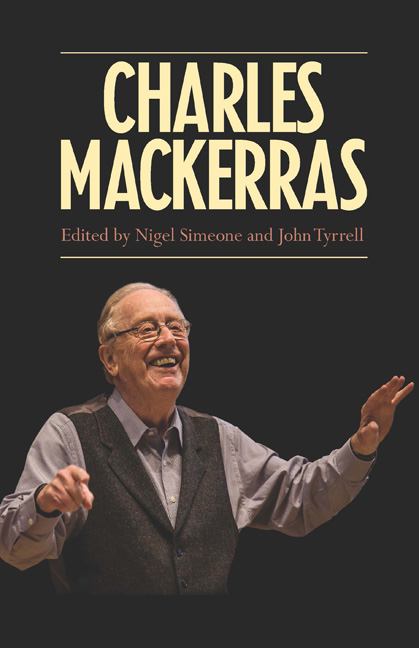Book contents
- Frontmatter
- Dedication
- Contents
- List of Illustrations
- List of Abbreviations
- Preface and Acknowledgments
- About the Contributors
- Charles Mackerras: A Chronology
- Prologue: A Eulogy for Charles
- 1 An Immense Stylist Evolves: 1947–87
- 2 A Personal Portrait of Charles Mackerras
- 3 Mackerras and Janáček
- 4 Goat's Milk in Vienna: Three Memorable Meetings
- 5 The Lion: Charles Mackerras
- 6 ‘The Musical Values of Opera’: WNO, 1987–92
- 7 Triumphs and Tribulations: Opera, 1993–2001
- 8 Rethinking Old Favourites: Opera, 2002–10
- 9 The Last Great ‘Czech’ Conductor
- 10 Reminiscences of a Friend and Colleague
- 11 Reconstructing a Better Version of The Greek Passion
- 12 Reconstructing Sullivan's Cello Concerto
- 13 Three Orchestras
- 14 Coda
- Appendix 1 Mackerras in Performance
- Appendix 2 Desert Island Lists
- Discography
- Bibliography
- Editions and Arrangements by Charles Mackerras
- Index
Preface and Acknowledgments
Published online by Cambridge University Press: 05 May 2015
- Frontmatter
- Dedication
- Contents
- List of Illustrations
- List of Abbreviations
- Preface and Acknowledgments
- About the Contributors
- Charles Mackerras: A Chronology
- Prologue: A Eulogy for Charles
- 1 An Immense Stylist Evolves: 1947–87
- 2 A Personal Portrait of Charles Mackerras
- 3 Mackerras and Janáček
- 4 Goat's Milk in Vienna: Three Memorable Meetings
- 5 The Lion: Charles Mackerras
- 6 ‘The Musical Values of Opera’: WNO, 1987–92
- 7 Triumphs and Tribulations: Opera, 1993–2001
- 8 Rethinking Old Favourites: Opera, 2002–10
- 9 The Last Great ‘Czech’ Conductor
- 10 Reminiscences of a Friend and Colleague
- 11 Reconstructing a Better Version of The Greek Passion
- 12 Reconstructing Sullivan's Cello Concerto
- 13 Three Orchestras
- 14 Coda
- Appendix 1 Mackerras in Performance
- Appendix 2 Desert Island Lists
- Discography
- Bibliography
- Editions and Arrangements by Charles Mackerras
- Index
Summary
The idea for this book came originally from members of the Mackerras family, particularly Charles's widow, Judy, who saw the text in proof before her death on 13 December 2014, his daughter Catherine (Cathy) and his sisters Joan and Elizabeth. Since both authors have been passionate admirers of Mackerras's conducting for many years, it was an opportunity we relished. At our initial meeting with Cathy, she encouraged us to develop the project as we thought best, and offered generous support. This included access to her father's private papers, which has enabled us to publish a number of letters and documents for the first time, shedding light on several significant aspects of his career and his working methods. An important consideration from the outset was how our book could usefully complement Nancy Phelan's admirable 1987 biography, Charles Mackerras: A Musician's Musician. One obvious way was to concentrate on the years since Phelan's book was published, which included some of the busiest and most rewarding of Charles's career. Moreover, this book was an opportunity to evaluate the whole of a remarkable life in music. To do that more effectively, we decided to include chapters on specific composers and on his relationships with particular musicians, opera companies and orchestras.
This book is neither a conventional biography, nor is it a symposium, but it aims to combine elements of both: chapters on periods in Mackerras's career are interwoven with more specialised essays and shorter contributions which aim to illuminate his approach to music-making from those who saw it at close quarters. To do this effectively, we asked a number of people who worked closely with Mackerras to write about their collaborations with him. The response from all those we asked was unfailingly positive, and their contributions are informative as well as affectionate, helping the reader to understand more fully how he worked and some of the life-long musical enthusiasms that drove him.
- Type
- Chapter
- Information
- Charles Mackerras , pp. xi - xiiiPublisher: Boydell & BrewerPrint publication year: 2015



